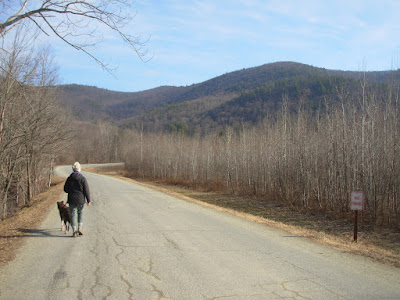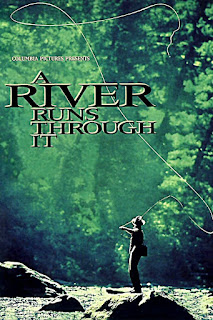Old friends full of new surprises always make me smile. Take the Battenkill State Forest. To me it's like an old friend that shares new secrets every time we get together. Running through this relationship is the Battenkill itself and the whole "No man ever steps in the same river twice" thing. The flow of water and time keep a stream both familiar and fresh. Like a friend that's always constant, but also always changing.
The 535 acre state forest was created in 2000 with the purchase of the Bentley property. It's in the Town of Jackson between Cambridge and the Vermont border. Rt. 313 cuts through it with most of the acreage on the southeastern "hill" side and most of the use on the northwestern "river" side. The river, of course, is the Battenkill which slices thru the Taconics, then delineates part of the forest's boundary before meandering across Washington County to empty into the Hudson at Clarks Mills.
State forests are managed for multiple-use objectives, including watershed protection, wildlife habitat, recreation and timber production. It should be noted that these lands are distinct from the forest preserve which is located within the Adirondack and Catskill State Parks. Washington County has both types of state lands with five state forests and the Carters Pond Wildlife Management Area to the south and large blocks of forest preserve in the northern towns of Fort Ann, Dresden and Putnam. There are also additional DEC lands near Whitehall that are outside the Adirondack Park. All of these are covered by Unit Management Plans with one being recently completed for the five state forests and Carters Pond.Several meetings were held at the Cambridge High School to gather public input. For maps and more information on the UMP try contacting Senior Forester Ben Thomas at the Warrensburg DEC office (518-623-1200).

Before there was a state forest there was simply the river. It's been a part of my life for as long as I can remember. Swimming, of course, and a little paddling. Also this odd little endeavor I call hiking the Battenkill. Nothing more than wading downstream, floating the deeper holes, taking to the shore when I see a fisherman ahead that I don't want to disturb. The perfect way to spend a hot summer day - no tubes required. On the subject of fishing, sadly, I was born without the patience to do it. For me it's a spectator sport. I just love to watch the grace and skill of a good fly-caster in action.
With the creation of the state forest came new ways to enjoy. I've run and skied and bushwhacked both along the river and in the high hills beyond 313. And there's no better place to launch long bike tours through out southern Washington County and into Vermont. When you come back hot and sweaty, the river is there to cool and soothe you.
Lately (maybe advancing age has something to do with it) I can be happy just quietly studying the geology, botany, birds and wildlife. Sometimes simply relaxing by the river with a good book is enough. Picture an older couple who, after a life of passionate lovemaking, are content to sit on a park bench holding hands. You slow down but discover that it's not such a bad thing.
But in my reading I've come across curiosities that begged for further investigation. Time to get back out there and poke around (however slowly). That's what I've been doing lately and I wanted to fill you in on what I've found.
Let's begin with a dramatic introduction. From the hamlet side, in the Town of Salem, walk across the Eagleville Covered Bridge. Take in the smell of old wood and the softly echoing sounds of your footsteps. Watch the southern entrance grow from a little square of light at the end of a dark tunnel to a large frame for the landscape beyond. Most of what you see in that frame is the Battenkill State Forest. To the left is the river, to the right a copse of young trees and between them is the road leading your gaze up towards a high wooded ridge in the distance.

The forest is somewhat disjointed, being sliced by Rt. 313 which runs from Cambridge east to Arlington, Vermont and then further bisected by the Eagleville Road between 313 and the bridge. Probably 99.9% of the areas activity occurs at the bridge and a parking spot just a few hundred feet up the road. The river is obviously the thing, much loved. Perhaps better words would be "lusted over". On hot summer days this can become quite the scene. Here epic tubing voyages begin, end and are celebrated while young women flash as much skin as the law allows and guys display their bravado with beer and vulgarities. But don't be discouraged. A simple check of your thermometer is all it takes. Sunny and above 85 degrees, leave it to the party people. The rest of the time is for us.
From the parking pull-off on Eagleville Road a fisherman's path leads upstream. You can wander for a half-mile or so before coming to the Battenkill Lodge's private property. The bank here is lined with picturesque sycamores and cottonwoods. In summer it's lush with ferns and wildflowers. There are old river channels and traces of a dam associated with a large woolen mill which once dominated Eagleville. All that's left are a few foundations. Gifted photojournalist Grey Villet lived across the stream and the noted sportsman/writer Lee Wulff owned a swath of riverbank here. Now, a noted blogger pays taxes on a little chunk of it.

Back at the parking area, look across the road where you'll notice a dense stand of young aspens, birch and scattered white pine. You're looking at controversy. This used to be a corn field until the state bought it fifteen years ago. The soils here are among the most fertile in the county - deep, level silt loams formed in flood plain alluvium. Many local people feel they should remain in production, but DEC decision makers obviously feel otherwise. While high input row crops such as corn may have a negative effect on the river, there are other options. The land could have been used for hay or alternately, offered to some young farmers for organic vegetable growing. Unfortunately, the current situation has fostered mistrust and animosity between the community and state managers.
In any case, it's an opportunity to watch forest regeneration in action. Starting from bare ground less than twenty years ago you can observe what has developed to date and watch it evolve into the future.
On the other side of the road to the east there seems to be some bush-hogging to maintain open areas while allowing other sections to revert to forest. Perhaps this is an attempt to create a variety of habitat types and edge environments that benefit diverse wildlife. This part of the state forest also holds an important site in the Philip Embury story of bringing the Methodist faith to America. Beyond Rt. 313 and high up the hillside is yet another interesting feature, an oak woodland of considerable ecological significance. We'll explore these in upcoming posts.
placebook -
If this post's title sounds familiar, it's because I've just finished reading Norman Maclean's
A River Runs Through It. For the third (or is it the fourth?) time. It's set in 1930's era western Montana, but it makes me think of the Battenkill. In 1992 Robert Redford turned the story into a movie starring Brad Pitt. I haven't seen the film but it's only been out for about 25 years. What's the rush? I'm more of a reading type guy and Maclean's writing is to be savored. The novella's opening and closing lines are literary gems. It's the tale of two brothers, the complicated web of emotions within a family and what we can and cannot do for one another. Rivers and fly-fishing are almost like characters in the book. The Big Blackfoot and the Elkhorn are the stages where Norman and his brother Paul's drama unspools. This is literature of place at its best. Hope you get to read it soon.











































